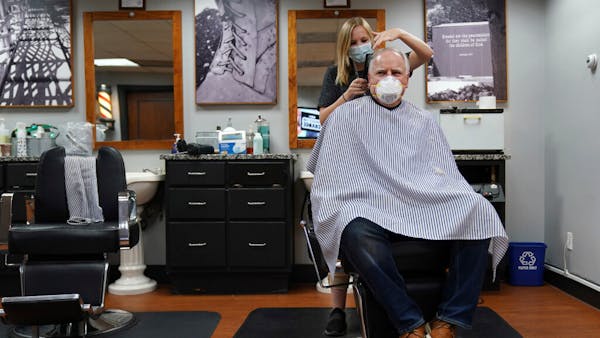The growth rate of newly diagnosed cases of COVID-19 is slowing in Minnesota, even as the number of tests to detect the viral respiratory illness continues to climb, the latest data showed Sunday.
The moderating trends are happening as the state prepares for its latest round of loosening restrictions on businesses and public places.
An executive order from Gov. Tim Walz will allow limited reopenings of dine-in restaurants, gyms and smaller entertainment venues on Wednesday, if the businesses take steps to control the spread of the virus.
"As we face the likelihood of many more months of this disease spreading at various levels in our communities, we must find a way to live with it — accepting a certain level of risk while taking steps to prevent a wave of cases overwhelming our health care sector," Minnesota Health Commissioner Jan Malcolm said in Friday's announcement of the changes.
On Sunday, the Minnesota Department of Health added 388 people to its overall tally of confirmed COVID-19 cases, the second-lowest daily total since April 28.
The growth rate of new cases has been slowing for two weeks. Using rolling averages to smooth out daily fluctuations, the daily increase in confirmed case counts has been declining on both a seven-day and a 14-day basis since hitting a high-water mark of about 700 new cases on May 24.
Delays in the system for reporting new confirmed cases make it difficult to precisely track trends over the prior week, but state health officials acknowledged over the weekend that the growth rate of new cases may have plateaued.
Change is also evident in the number of people getting intensive and regular levels of COVID-19 care in hospitals.
On Sunday, there were 199 people in hospital intensive-care units being treated for COVID-19, the lowest total since May 13. An additional 251 people were getting care in regular hospital beds Sunday, the lowest since May 10.
Of the 1.9 million cases of COVID-19 that have been diagnosed nationally, 27,886 have been in Minnesota, including nearly 3,000 health care workers. About 23,000 Minnesotans have recovered from their symptoms and no longer need to remain in isolation, according to the Health Department.
Of the 16 new Minnesota fatalities reported Sunday, 14 of the people lived in long-term care, assisted living, or group homes for behavioral health. All of the new deaths except one in Hennepin County were people who were at least 60 years old.
The average rate of newly reported deaths has been relatively steady for weeks — the seven-day average has floated between 20 and 25 since May 20.
All told, 1,186 Minnesotans have died with confirmed cases of the illness. More than 90% of those were 60 or older, according to a Star Tribune analysis of the state data.
People at higher risk for severe cases include the elderly and people in group-living facilities, where social distancing and pandemic hygiene are difficult. Underlying health factors contribute to higher risks, including lung disease, moderate to severe asthma, serious heart conditions, immunocompromise, obesity with BMI over 40, diabetes, liver disease, and chronic kidney disease requiring dialysis.
The virus that causes COVID-19 makes some people very ill, while some feel no physical effects at all.
Around 80% of people who get the virus experience mild to no symptoms, while as many as 5% require critical care in a hospital.
Common mild symptoms include fever, body aches, cough, fatigue, chills and loss of smell, though some people have more significant symptoms like a high fever, severe coughing or shortness of breath that may indicate pneumonia.
The Centers for Disease Control and Prevention says emergency medical attention should be sought for people who have trouble breathing, persistent pain or pressure in the chest, new onset of confusion, inability to wake or stay awake, or "bluish" lips or face. Symptoms generally appear within five days of exposure but can take up to 14.
Monday marks the 14th day since the death of George Floyd, a black man who died after a white Minneapolis police officer, Derek Chauvin, knelt on his neck for more than eight minutes.
Outrage stemming from Floyd's death brought thousands of people to the streets to protest and demonstrate, causing public health officials to urge everyone who protested in Minnesota to get tested for COVID-19.
June 3 saw the highest number of test results for COVID-19 reported in a single day, with more than 15,000 tests performed by private labs.
Totals from the current week are subject to change, and some people in the state have been tested more than once.
Saturday marked the fourth consecutive day of more than 10,000 test results being reported.
Joe Carlson • 612-673-4779

Former MnDOT official approved as Minneapolis public works director

Jury selected for Feeding Our Future trial after unusually long process due to publicity of massive fraud case

911 transcript gives more detail of Sen. Mitchell's alleged burglary
Man shot by deputy in Montrose allegedly said during earlier clash he'd rather die than be arrested

